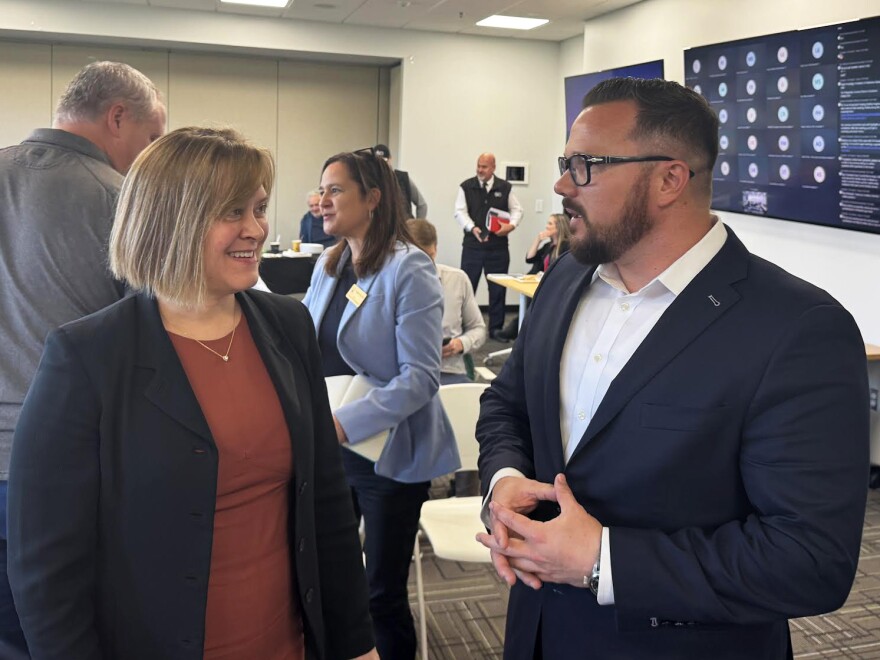There’s a lot that’s still unknown about the Alaska LNG Project. And one question that’s been on the backburner is whether Alaska can accommodate the logistics associated with building a pipeline project of its scale. That’s the focus of a new group of state lawmakers that convened for the first time Tuesday in Anchorage.
The so-called Alaska Gasline Caucus was started and is co-chaired by Anchorage’s Rep. Mia Costello and Sutton’s Rep. George Rauscher, both Republicans. Nikiski Republican Sen. Jesse Bjorkman is also a member.
“It's a caucus to examine the gas line project and moving forward, how the state can prepare – best prepare – for this massive opportunity that is on our doorstep here,” Costello said.
The three-hour meeting kicked off with a general project status update from Adam Prestidge. He’s president of the Alaska LNG Project under Glenfarne Group, which assumed majority project ownership earlier this year.
If it’s built, the three-phase project would extract and treat natural gas on the North Slope, move it through an 807-mile pipeline to Southcentral and liquefy it in Nikiski for export overseas. Prestidge says right now, Glenfarne says its focusing on the project’s first phase – the pipeline. The company says the pipeline can stand on its own and deliver gas to in-state customers and lower the investment risk associated with the project’s other pieces.
“This is a project that carries with it a deep responsibility to the state of Alaska, to Alaskan citizens, and we carry that responsibility very deep held in everything we do, in everything we do, in every decision that we make about this project,” he told lawmakers.
The project has been floated for decades. More recently, though, it became the focus of renewed attention after Russia’s invasion of Ukraine sent global markets looking to divest from Russian energy supplies.
And just this year, the project netted early-stage agreements from four companies around the world. It’s been the subject of White House praise and an executive order. And project owners say they’re on track to decide whether to build the pipeline or not by the end of this year. That decision would be farther than the project has ever gone before.
And Prestidge says Glenfarne is in it for the long haul.
“We made a commitment to ourselves and to AGDC and to the governor that we did not want to be and we don’t intend to and we won't be another Lower 48 firm that comes up, develops something and then it doesn't create an opportunity for Alaskans,” he said.
But during Tuesday’s inaugural caucus meeting, lawmakers asked state education and labor leaders whether Alaska is up to the challenge.

Teri Cothren says kind of. She’s the University of Alaska’s associate vice president of workforce development and told lawmakers the university system has demonstrated success among its oil and gas programs. But she says the work associated with building an 807-mile pipeline has broader workforce implications.
“When you think about the size of a project like this, where you will have an influx of people to the state, you're going to need more healthcare, you need teachers that educate, maybe an influx of those families and students, those are other areas that we help support as well,” she said.
The problem is the university system’s capacity. That’s according to University of Alaska Fairbanks Vice Chancellor Bryan Uher.
“It's not recruitment – the students want it,” he said. “They are here. They're banging down our doors, and it's just we physically cannot take any more because of our facility limitations that we're facing right now.”
He predicts a project like AK LNG will create a high level of competition for the limited pool of skilled workers. Expanding the number of students the university system can serve, Uher says, would benefit Alaska’s other industrial projects if the LNG pipeline fails to come to fruition.
Alaska labor leaders say they’re taking inventory of their own workforce assets, too.
Cathy Munoz is the commissioner of the Alaska Department of Labor and Workforce Development. She told lawmakers Alaskans are unlikely to meet all of the pipeline’s workforce demands.
“We recognize with a project like the gasline that we will need to import some labor,” she said.
So, she says the department is updating its 2018 Gasline Workforce Plan. They’ve updated state regulations to make it easier for out-of-state plumbers and electricians to find in-state work. The department now recognizes military experience when considering license applications. And they’ve expanded the pool of proctors eligible to administer industry exams around the state.
By the end of Tuesday’s meeting, the caucus co-chairs said some of their questions were answered, and the information had raised a few more. Here’s Rep. Costello again.
“I think one of the messages we heard today is that there are so many jobs that we will need filled and it's an all hands on deck situation in terms of preparing Alaskans,” she said.
Glenfarne’s visit to Alaska brought them to the Kenai Peninsula on Wednesday. Prestidge and others held a community town hall at the Nikiski Community Recreation Center.



